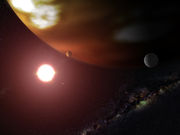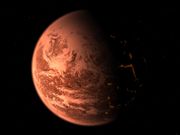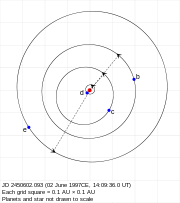Gliese 876
| Observation data Epoch J2000.0 Equinox J2000.0 |
|
|---|---|
| Constellation | Aquarius |
| Pronunciation | /ˈɡliːzə/ |
| Right ascension | 22h 53m 16.7339s[1] |
| Declination | –14° 15′ 49.322″[1] |
| Apparent magnitude (V) | 10.1480[2] |
| Characteristics | |
| Spectral type | M4V |
| U−B color index | 1.15 |
| B−V color index | 1.59 |
| R−I color index | 1.22 |
| Variable type | BY Draconis |
| Astrometry | |
| Radial velocity (Rv) | –1.7 ± 2 km/s |
| Proper motion (μ) | RA: +960.33 ± 3.77 mas/yr Dec.: –675.64 ± 1.58 mas/yr |
| Parallax (π) | 213.28 ± 2.12[2] mas |
| Distance | 15.3 ± 0.2 ly (4.69 ± 0.05 pc) |
| Absolute magnitude (MV) | 11.81 |
| Details | |
| Mass | 0.334 ± 0.03[3] M☉ |
| Radius | 0.36 R☉ |
| Surface gravity (log g) | 4.89[4] |
| Luminosity | 0.013[3] L☉ |
| Temperature | 3350 ± 300 K |
| Metallicity | 76% solar[4] |
| Rotation | 96.9[3] days |
| Rotational velocity (v sin i) | 1.38[3] km/s |
| Age | 0.1–9.9[3][5] Gyr |
| Other designations | |
| Database references | |
| SIMBAD | data |
| NStED | data |
| ARICNS | data |
| Extrasolar Planets Encyclopaedia |
data |
| Data sources: | |
| Hipparcos Catalogue, CCDM (2002), Bright Star Catalogue (5th rev. ed.) |
|
Gliese 876 is a red dwarf star approximately 15 light-years away from Earth in the constellation of Aquarius (the Water-bearer). As of 2010, it has been confirmed that four extrasolar planets orbit the star. Two of the middle planets are similar to Jupiter, while the closest planet is thought to be similar to a small Neptune or a large terrestrial planet, and the outer planet has mass similar to Uranus. The orbits of all but the closest planet are locked in a rare three-body Laplace resonance.
Contents |
Distance and visibility
Gliese 876 is located fairly close to our solar system. According to astrometric measurements made by the Hipparcos satellite, the star shows a parallax of 213.28 milliarcseconds,[2] which corresponds to a distance of 4.69 parsecs (15.3 ly). Despite being located so close to Earth, the star is so faint that it is invisible to the naked eye and can only be seen using a telescope.
Stellar characteristics
As a red dwarf star, Gliese 876 is much less massive than our Sun: estimates suggest it has only 32% of the mass of our local star.[6] The surface temperature of Gliese 876 is cooler than our Sun and the star has a smaller radius.[7] These factors combine to make the star only 1.24% as luminous as the Sun, and most of this is at infrared wavelengths.
Estimating the age and metallicity of cool stars is difficult due to the formation of diatomic molecules in their atmospheres, which makes the spectrum extremely complex. By fitting the observed spectrum to model spectra, it is estimated that Gliese 876 has a slightly lower abundance of heavy elements compared to the Sun (around 75% the solar abundance of iron).[4] Based on chromospheric activity the star is likely to be around 6.5 to 9.9 billion years old, depending on the theoretical model used.[5] However, the low rotational period of the star as well as its membership among the young disk population suggest that the star is between 0.1–5 billion years old.[3]
Like many low-mass stars, Gliese 876 is a variable star. Its variable star designation is IL Aquarii and it is classified as a BY Draconis variable. Its brightness fluctuates by around 0.04 magnitudes.[8] This type of variability is thought to be caused by large starspots moving in and out of view as the star rotates.[9] Gliese 876 emits X-rays.[10]
Planetary system
On June 23, 1998, an extrasolar planet was announced in orbit around Gliese 876 by two independent teams led by Geoffrey Marcy[6] and Xavier Delfosse.[11] The planet was designated Gliese 876 b and was detected by making measurements of the star's radial velocity as the planet's gravity pulled it around. The planet, around twice the mass of Jupiter, revolves around its star in an orbit taking approximately 61 days to complete, at a distance of only 0.208 AU, less than the distance from the Sun to Mercury.[12]

On April 4, 2001, a second planet was detected in the system, inside the orbit of the previously-discovered planet.[13] The 0.62 Jupiter-mass planet, designated Gliese 876 c is in a 1:2 orbital resonance with the outer planet, taking 30.340 days to orbit the star. This relationship between the orbital periods initially disguised the planet's radial velocity signature as an increased orbital eccentricity of the outer planet. Eugenio Rivera and J. Lissauer found that the two planets undergo strong gravitational interactions as they orbit the star, causing the orbital elements to change rapidly.[14]
Both of the system's Jupiter-mass planets are located in the 'traditional' habitable zone (HZ) of Gliese 876, which extends between 0.116 to 0.227 AU from the star.[15]

On June 13, 2005, further observations by a team led by Rivera revealed a third planet in the system, inside the orbits of the two Jupiter-size planets.[16] The planet, designated Gliese 876 d, was estimated to have a minimum mass only 5.88 times that of the Earth and may be a terrestrial planet.
In 2008, the system was used as a test case for the migration of 5 Earth-mass planets which had formed inside the orbit of the innermost gas giant of the system. If it formed at (in this test) 0.07 AU from the star, b's gravity would have pulled d into an eccentric orbit. That orbit then would have restabilised to its current location.[17]
In January 2009, the mutual inclination between planets b and c was determined using a combination of radial velocity and astrometric measurements. The planets were found to be almost coplanar, with an angle of only 5.0+3.9−2.3° between their orbital planes.[18] It is the first planetary system around a normal star to have mutual inclination between planets measured (previously the mutual inclination of the planets orbiting the pulsar PSR B1257+12 had been determined by measuring their gravitational interactions[19]). Later measurements reduced the value of the mutual inclination,[3] and in the latest four-planet models the incorporation mutual inclinations does not result in significant improvements relative to coplanar solutions.[20]

On June 23, 2010, astronomers announced the discovery of a fourth planet (designated Gliese 876 e) in a 1:2:4 Laplace resonance with Gliese 876 b and c. This is the second known example of a Laplace resonance, the first being Jupiter's moons Ganymede, Europa and Io. This discovery better constrains the mass and orbital properties of the other three planets, including the high eccentricity of the innermost planet. Numerical integration indicates that the coplanar, four-planet system is stable for at least another billion years. This planetary system comes close to a triple conjunction between the three outer planets once per orbit of the outermost planet.[20]
| Companion (in order from star) |
Mass | Semimajor axis (AU) |
Orbital period (days) |
Eccentricity |
|---|---|---|---|---|
| d | 6.83 ± 0.40 M⊕ | 0.02080665 ± 0.00000015 | 1.937780 ± 0.000020 | 0.207 ± 0.055 |
| c | 0.7142 ± 0.0039 MJ | 0.129590 ± 0.000024 | 30.0081 ± 0.0082 | 0.25591 ± 0.00093 |
| b | 2.2756 ± 0.0045 MJ | 0.208317 ± 0.000020 | 61.1166 ± 0.0086 | 0.0324 ± 0.0013 |
| e | 14.6 ± 1.7 M⊕ | 0.3343 ± 0.0013 | 124.26 ± 0.70 | 0.055 ± 0.012 |
See also
- Gliese 876 in fiction
- List of nearest stars
- List of extrasolar planets
Notes
- ↑ Uncertainties in the planetary masses and semimajor axes do not take into account the uncertainty in the mass of the star.
References
- ↑ 1.0 1.1 Perryman, M. A. C.; Lindegren, L.; Kovalevsky, J.; Hoeg, E.; Bastian, U.; Bernacca, P. L.; Crézé, M.; Donati, F.; Grenon, M.; van Leeuwen, F.; van der Marel, H.; Mignard, F.; Murray, C. A.; Le Poole, R. S.; Schrijver, H.; Turon, C.; Arenou, F.; Froeschlé, M.; Petersen, C. S. (April 1997). "The HIPPARCOS Catalogue". Astronomy and Astrophysics 323: L49–L52. Bibcode: 1997A&A...323L..49P.
- ↑ 2.0 2.1 2.2 van Leeuwen, Floor (2007). Hipparcos, the new Reduction of the Raw data. Astrophysics and Space Science Library. 350. ISBN 9781402063411. Bibcode: 2007A&A...474..653V. Note: see VizieR catalogue I/311.
- ↑ 3.0 3.1 3.2 3.3 3.4 3.5 3.6 Correia, A. C. M.; Couetdic, J.; Laskar, J.; Bonfils, X.; Mayor, M.; Bertaux, J.-L.; Bouchy, F.; Delfosse, X.; Forveille, T.; Lovis, C.; Pepe, F.; Perrier, C.; Queloz, D.; Udry, S. (February 2010). "The HARPS search for southern extra-solar planets. XIX. Characterization and dynamics of the GJ 876 planetary system". Astronomy and Astrophysics 511: A21. doi:10.1051/0004-6361/200912700. Bibcode: 2010A&A...511A..21C.
- ↑ 4.0 4.1 4.2 Bean, Jacob L.; Benedict, G. Fritz; Endl, Michael (December 2006). "Metallicities of M Dwarf Planet Hosts from Spectral Synthesis". Astrophysical Journal Letters 653 (1): L65–L68. doi:10.1086/510527. Bibcode: 2006ApJ...653L..65B.
- ↑ 5.0 5.1 Saffe, C.; Gómez, M.; Chavero, C. (November 2005). "On the Ages of Exoplanet Host Stars". Astronomy and Astrophysics 443 (2): 609–626. doi:10.1051/0004-6361:20053452. Bibcode: 2005A&A...443..609S. http://cdsads.u-strasbg.fr/cgi-bin/nph-bib_query?2005A%26A...443..609S&db_key=AST&nosetcookie=1.
- ↑ 6.0 6.1 Marcy, Geoffrey W.; Butler, R. Paul; Vogt, Steven S.; Fischer, Debra; Lissauer, Jack J. (October 1998). "A Planetary Companion to a Nearby M4 Dwarf, Gliese 876". The Astrophysical Journal Letters 505 (2): L147–L149. doi:10.1086/311623. Bibcode: 1998ApJ...505L.147M. http://cdsads.u-strasbg.fr/cgi-bin/nph-bib_query?1998ApJ...505L.147M&db_key=AST&nosetcookie=1.
- ↑ Johnson, H. M.; Wright, C. D. (November 1983). "Predicted infrared brightness of stars within 25 parsecs of the sun". The Astrophysical Journal Supplement Series 53: 643–711. doi:10.1086/190905. Bibcode: 1983ApJS...53..643J.
- ↑ Samus et al. (2007–2010). "IL Aqr". Combined General Catalogue of Variable Stars. http://vizier.u-strasbg.fr/viz-bin/VizieR-S?V%2A%20IL%20Aqr. Retrieved 2010-06-28.
- ↑ Bopp, B.; Evans, D. (1973). "The spotted flare stars BY Dra, CC Eri: a model for the spots, some astrophysical implications". Monthly Notices of the Royal Astronomical Society 164: 343–356. Bibcode: 1973MNRAS.164..343B. http://adsabs.harvard.edu/cgi-bin/nph-bib_query?bibcode=1973MNRAS.164..343B&db_key=AST&data_type=HTML&format=.
- ↑ Schmitt, Jürgen H. M. M.; Fleming, Thomas A.; Giampapa, Mark S. (September 1995). "The X-ray view of the low-mass stars in the solar neighborhood". The Astrophysical Journal 450: 392–400. doi:10.1086/176149. Bibcode: 1995ApJ...450..392S.
- ↑ Delfosse, X.; Forveille, T.; Mayor, M.; Perrier, C.; Naef, D.; Queloz, D. (October 1998). "The closest extrasolar planet. A giant planet around the M4 dwarf GL 876". Astronomy and Astrophysics 338: L67–L70. Bibcode: 1998A&A...338L..67D.
- ↑ Butler, R. P.; Wright, J. T.; Marcy, G. W.; Fischer, D. A.; Vogt, S. S.; Tinney, C. G.; Jones, H. R. A.; Carter, B. D.; Johnson, J. A.; McCarthy, C.; Penny, A. J. (December 2006). "Catalog of Nearby Exoplanets". The Astrophysical Journal 646 (1): 505–522. doi:10.1086/504701. Bibcode: 2006ApJ...646..505B.
- ↑ Marcy, Geoffrey W.; Butler, R. Paul; Fischer, Debra; Vogt, Steven S.; Lissauer, Jack J.; Rivera, Eugenio J. (July 2001). "A Pair of Resonant Planets Orbiting GJ 876". The Astrophysical Journal 556 (1): 296–301. doi:10.1086/321552. Bibcode: 2001ApJ...556..296M.
- ↑ Rivera, Eugenio J.; Lissauer, Jack J. (September 2001). "Dynamical Models of the Resonant Pair of Planets Orbiting the Star GJ 876". The Astrophysical Journal 558 (1): 392–402. doi:10.1086/322477. Bibcode: 2001ApJ...558..392R.
- ↑ Jones, Barrie W.; Underwood, David R.; Sleep, P. Nick (April 2005). "Prospects for Habitable "Earths" in Known Exoplanetary Systems". The Astrophysical Journal 622 (2): 1091–1101. doi:10.1086/428108. Bibcode: 2005ApJ...622.1091J.
- ↑ Rivera, Eugenio J.; Lissauer, Jack J.; Butler, R. Paul; Marcy, Geoffrey W.; Vogt, Steven S.; Fischer, Debra A.; Brown, Timothy M.; Laughlin, Gregory et al. (November 2005). "A ~7.5 M⊕ Planet Orbiting the Nearby Star, GJ 876". The Astrophysical Journal 634 (1): 625–640. doi:10.1086/491669. Bibcode: 2005ApJ...634..625R.
- ↑ Zhou, Ji-Lin; Lin, Douglas N. C. (May 2008). "Migration and Final Location of Hot Super Earths in the Presence of Gas Giants". 249. Exoplanets: Detection, Formation and Dynamics, Proceedings of the International Astronomical Union, IAU Symposium. pp. 285–291. http://adsabs.harvard.edu/abs/2008IAUS..249..285Z.
- ↑ Bean, J. L.; Seifahrt, Andreas (March 2009). "The architecture of the GJ876 planetary system. Masses and orbital coplanarity for planets b and c". Astronomy and Astrophysics 496 (1): 249–257. doi:10.1051/0004-6361/200811280. Bibcode: 2009A&A...496..249B.
- ↑ Konacki, Maciej; Wolszczan, Alex (July 2003). "Masses and Orbital Inclinations of Planets in the PSR B1257+12 System". The Astrophysical Journal 591 (2): L147–L150. doi:10.1086/377093. Bibcode: 2003ApJ...591L.147K.
- ↑ 20.0 20.1 20.2 Rivera, Eugenio J.; Laughlin, Gregory; Butler, R. Paul; Vogt, Steven S.; Haghighipour, Nader; Meschiari, Stefano (June 2010). "The Lick-Carnegie Exoplanet Survey: A Uranus-mass Fourth Planet for GJ 876 in an Extrasolar Laplace Configuration". arΧiv:1006.4244v1 [astro-ph.EP].
External links
- "Artist renderings and data for the three planets orbiting GJ 876". http://exoplanets.org/gl876_web/gl876_graphics.html. Retrieved 2008-06-21.
- "A Dangerous Sunrise on Gliese 876d". NASA. Astronomy Picture of the Day. 2008-05-21. http://apod.nasa.gov/apod/ap080521.html. Retrieved 2008-06-21.
- "A planet for Gliese 876". NASA. Astronomy Picture of the Day. 1998-06-26. http://antwrp.gsfc.nasa.gov/apod/ap980626.html. Retrieved 2008-06-21.
- "Gliese 876". Extrasolar Visions. http://www.extrasolar.net/startour.asp?StarID=2. Retrieved 2008-06-21.
- "Gliese 876 / Ross 780". SolStation. http://www.solstation.com/stars/gl876.htm. Retrieved 2008-06-21.
- "Gliese 876 : THE CLOSEST EXTRASOLAR PLANET". Observatoire de Haute Provence. http://www.obs-hp.fr/www/nouvelles/gl876.html. Retrieved 2008-06-21.
- "Smallest extrasolar planet found". BBC News. 2005-06-13. http://news.bbc.co.uk/2/hi/science/nature/4089534.stm. Retrieved 2008-06-21.
- Image Gliese 876
- Extrasolar Planet Interactions by Rory Barnes & Richard Greenberg, Lunar and Planetary Lab, University of Arizona
- Sky map
|
|||||||||||
|
|||||||||||||||||||||||||||||||||||||||||||||||||||||||||||||||||||||||||||||||||||||||||||||||||||||||||||||||||||||||||||||||||||||||||||||||||||||||||||||||||||||||||||||||||||||||||||||||||||||||||||||
Coordinates: ![]() 22h 53m 16.7s, −14° 15′ 49″
22h 53m 16.7s, −14° 15′ 49″